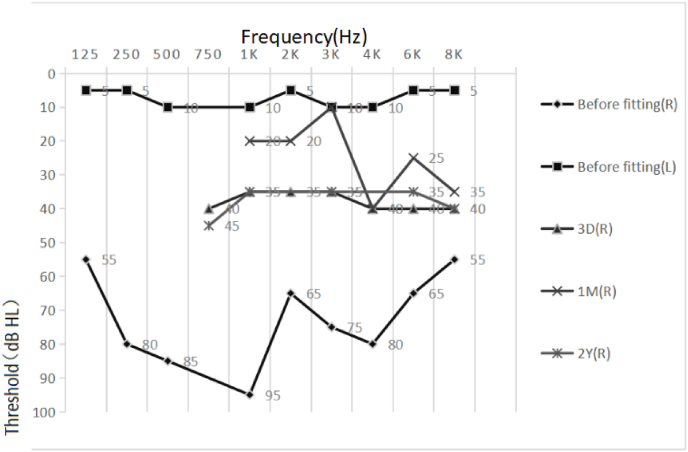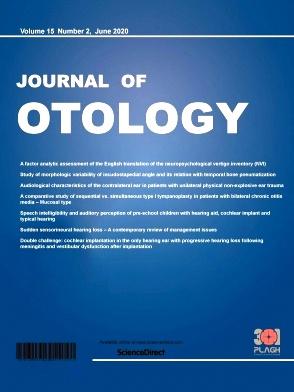成人单侧耳聋配戴骨传导助听器1例效果分析。
IF 1.4
Q2 OTORHINOLARYNGOLOGY
引用次数: 0
摘要
听力障碍患者中单侧耳聋(SSD)或不对称听力损失(AHL)的患病率为7.2% ~ 15.0%,占比较显著。然而,这些人往往忽视他们的听力损失,导致延迟或不充分的治疗。这种疏忽可能导致双耳求和和静音效果的缺乏,以及头部阴影效应,这可能会严重影响他们的语音识别和声音定位能力,特别是在嘈杂的环境中。最近,突破性的Sound Bite™拼音®骨传导助听器(HA)设备已经推出,作为传统经皮刺激助听器的可行替代方案。这种创新的设备利用骨传导技术,通过颌骨和颅骨将声音振动直接传递到内耳,有效地绕过了听力损失患者通常受损的空气传导途径。本报告详细介绍了一名患有先天性右耳听骨链畸形的31岁女性患者在保持左耳正常听力的情况下佩戴HA装置的评估和调整过程。该报告全面涵盖了该31岁女性患者配戴助听器当日及一个月后的听力阈值。它还通过助听器效益简要介绍(APHAB)问卷对助听器的性能进行评估,在调整后三天,一个月和一年后进行。此外,该报告还详细评估了患者的声音定位能力,比较了患者佩戴助听器前后的表现。此外,它还包括测量她对单音节单词和洋洋歌单词的语音识别能力,这是在初次安装助听器两年后进行的汉语特定测试。骨锚定助听器的发现可以显著提高单侧传导性听力损失患者的听力阈值,这是一个重要的里程碑。这些设备不仅提高了语音识别能力,还增强了嘈杂环境下的声音定位能力。这种改善伴随着患者的高水平主观满意度,表明对他们的整体生活质量有积极的影响。本文章由计算机程序翻译,如有差异,请以英文原文为准。



Effect analysis of unilateral deaf adults wearing bone-conduction hearing aids: A case report
The prevalence of unilateral deafness (SSD) or asymmetric hearing loss (AHL) among patients with hearing impairments ranges from 7.2% to 15.0%, indicating a relatively significant proportion. However, these individuals often overlook their hearing loss, resulting in delayed or inadequate treatment. This oversight can lead to a lack of binaural summation and squelch effect, as well as the head shadow effect, which can significantly impact their speech recognition and sound localization abilities, especially in noisy environments.Recently, a groundbreaking Sound Bite™ Pinyin® Bone Conduction Hearing Aid (HA) device has been has been introduced as a viable alternative to traditional percutaneous stimulation hearing assistance devices. This innovative device harnesses bone conduction technology to convey sound vibrations directly to the inner ear via the bones of the jaw and skull, effectively bypassing the air conduction pathway that is commonly compromised in individuals with hearing loss.
This report details the evaluation and adjustment process of a HA device worn by a 31-year-old female patient who suffers from a congenital ossicular chain deformity in her right ear, while maintaining normal hearing in her left ear.The report comprehensively covers the hearing thresholds of the 31-year-old female patient on the day of fitting the hearing aid and one month later. It also presents assessments of the hearing aid's performance through the Abbreviated Profile of Hearing Aid Benefit (APHAB) questionnaire, conducted three days after adjustment, one month later, and one year later.Furthermore, the report details the evaluation of the patient's sound localization ability, comparing her performance before and after wearing the hearing aid device. Additionally, it includes measurements of her speech recognition ability for monosyllabic words and Yang Yang Ge words, which are specific tests in the Chinese language, conducted two years after the initial fitting of the hearing aid.The discovery that bone-anchored hearing devices can significantly enhance hearing thresholds in patients with unilateral conductive hearing loss represents a significant milestone. These devices not only improve speech recognition ability but also enhance sound localization in noisy environments. This improvement is accompanied by a high level of subjective satisfaction among patients, indicating a positive impact on their overall quality of life.
求助全文
通过发布文献求助,成功后即可免费获取论文全文。
去求助
来源期刊

Journal of Otology
Medicine-Otorhinolaryngology
CiteScore
2.70
自引率
0.00%
发文量
461
审稿时长
18 days
期刊介绍:
Journal of Otology is an open access, peer-reviewed journal that publishes research findings from disciplines related to both clinical and basic science aspects of auditory and vestibular system and diseases of the ear. This journal welcomes submissions describing original experimental research that may improve our understanding of the mechanisms underlying problems of basic or clinical significance and treatment of patients with disorders of the auditory and vestibular systems. In addition to original papers the journal also offers invited review articles on current topics written by leading experts in the field. The journal is of primary importance for all scientists and practitioners interested in audiology, otology and neurotology, auditory neurosciences and related disciplines. Journal of Otology welcomes contributions from scholars in all countries and regions across the world.
 求助内容:
求助内容: 应助结果提醒方式:
应助结果提醒方式:


